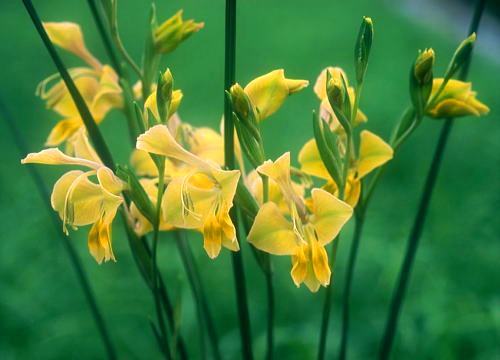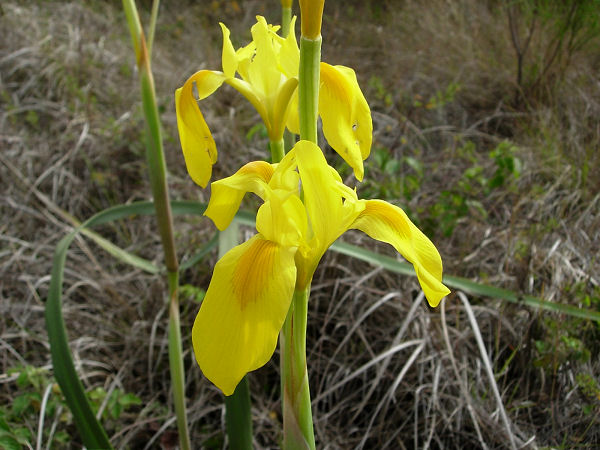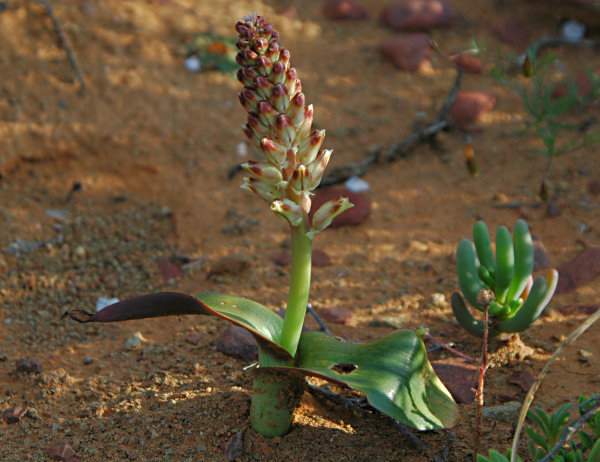 |
| Some Narcissus or other that was inherited from the previous tenant. It had clearly been a Mothers' Day gift or similar and dumped out the window when past, with almost no soil and only a sad little basket to call home. I potted it up about 5 years ago in a nice terracotta pot with not just fresh compost but the first compost the bulbs had seen in several years. It came up blind but healthy for a few years so I tipped them out, took the healthiest off-sets and replanted them. And here they are, flowering for the first time since at least 2004 |
Greetings fellow horticulturalists, how are we today? Welcome to my experiment in search engine optimisation, hence the meaningless title of todays post. I awoke very early, this being the day of London's historic and noisy Columbia Road Flower Market. So, unable to get back to sleep, I decided to get up and sow the rest of my Gladioli seed, which I've been putting off due to lack of compost, lack of grit, lack of pots and lack of enthusiasm. But I have now fashioned a suitable growing medium after a delivery of orchid compost (very open but not very barky), black glossy aquarium gravel, sand and a bit of JI3 I was saving for special occasion. So not much nutrient, which is right for most seed composts as the seedlings will only be in there for a few weeks and too much fertiliser can actually "burn" the delicate new roots. Although, as you'll discover, ours are going to be in the same pot and compost for up to two years.
 |
| The contents of a second cloche. The nine Gladioli in the background are waiting for space in the heated propagator and the Alstroemeria Hookeri, Babiana ambigua and Anomatheca laxa have already germinated, to varying degrees. I've just seen the weather forecast for tonight and we're possibly due a frost, so I hope the cloche is up to it, even if I do have doubles of the Alstroemeria and Anomatheca which have yet to germinate so should be OK |
And when you get to this level of enthusiasm, you can't affort to be wasteful: these scarce and hard to collect seeds usually come in packs of just five (seeds, not bags) so the usual etiquette, once the bulb (in the widest sense) seed (singular in many cases, a 20% success rate would be considered quite good if you had had 100) has/have germinated is to leave well alone for two seasons (so a deep pot, 10cm at least, is required), unless your distribution was as bad as mine and you have a traffic jam, or if one plant is particularly vigorous, in which case I would suggest transplanting the seedlings, as soon as they are robust enough to handle, to a bigger pot, using a dibber to make roughly equidistant holes and replant the seedlings at the same depth they had been at before. If in doubt, err on the side of deeper and spray with a fungicide to prevent the buried growth from damping off (that's gardener talk for rotting).
If your problem was a dominant bully, plant him up in a separate, much smaller, pot. There is a phenomenon whereby a single seedling planted in a big pot will sulk for a bit and then just die. I can't remember the science behind this but have passed the practical.
I have already successfully sown and germinated four Gladioli species and quite a few other genera like Moraea and Lachenalia, so while I'm hardly qualified on paper, I do have some green spikes you might want to covet.
My method with the first two batches was slightly different from the new ones: it is said that daily fluctuations in temperature help break the dormancy of Gladioli seed. I don't know whether this is true or an old wives' tale.
As the seed began to arrive at the end of last year, I did what I always do and read too much about winter/rain season flowering types and other very confusing things, especially when you keep in mind that the articles I was reading were written mostly by Americans or, naturally South Africans (their country being the goose that lays almost all these golden eggs (NB, must think of less offensive metaphor) apart from a few confusing magenta species around the Med, and possibly one UK native. So Winter in South Africa and America isn't in the same months as they are in London Town. And some grow in heavy clay, some in inaccessible crevices on mountain sides and some in scrubby grassland.
So I decided to do what I always end up doing: ignored it all and went with my instinct. Compost: a mix of bog standard potting compost, perlite, grit and sand. I left out any fertiliser for the reasons outlined above (god, this reads like a mortgage application). As they grow I can apply a liquid feed every 3 weeks or so during the growing season to build up the bulb, alternating with water to avoid any build-up of chemical salts in the compost.
So my sowing method is the same as I've adopted for almost everything this year: First take your pot, at least 10cm deep because the bulbs need to find their own depth so give them the depth to do it! Then fill to about 1cm from the top, press down gently (add a bit more growing medium if you need to) and give it a tap to flatten the surface but also break up the texture a bit, you don't want it flat and impenetrable (imagine you're an exhausted root). Next, OUT OF THE WIND, open your little drug dealers' packet of flat, papery seeds and tip them on to the compost surface. then, taking the point of your label or pencil or similar distribute them evenly. If you're using a square pot it should look something like the "5" on a die but without any seed less than 1cm from the edge. Finally, take your pick from perlite, vermiculite and very fine grit (check it is pH neutral if you bought it from the pet shop) and cover the seed almost to the top of the pot, that way light can penetrate but the seed is held in place and moisture comes from below, meaning it's not buried in soggy compost (although some species would like this, just don't ask me to remember which!) It also means that when you water you aren't going to disturb the seeds.
At this point I didn't have access to the heated propagator so my first four efforts: Gladioli segetum, watermeyeri, undulatus and hyalinus, had to go into the cold greenhouse, along with a lot of other stuff that was coming from South Africa and beyond, including Lachenalia viridiflora, that amazing turquoise Hyacinth and all the tender perennials from the summer. Slowly, the perennials (mostly utterly replaceable Pelargoniums and Fuchsias) were sacrificed as more and more seed began to overwhelm me ( that's the problem with the Web; previously I'd never have heard of bidorbuy.za, the South African eBay), Secret seeds, chileflora.com and rareplants.de. The most exotic I'd get would be the Chilterns catalogue (still my first stop but to be fair, I doubt if they've ever been to the Andes, never mind brought back a ton of seed and the knowledge to grow it!). And with it all being electronic, your partner doesn't have to know quite howe expensive the contents of that wee jiffy bag were!)
Then I brought the propagator from its hiding place deep in a kitchen cupboard. So in go the Glads, Moraeas, Babianas, Dipcadis etc. And I don't know if it was the stratification but Dipcadi serotinus was the first to give that skipped heartbeat one evening when the torch came out (it's easier to see a tiny tip amongst a load of vermiculite with one, even with the lights on). I couldn't move the propagator out of the shadows or lift the blind to let in enough light for photosynthesis so any plant left there for more than 24 hours was just going to etiolate and die. So I took a gamble and found a use for those six plastic cloches I'd ordered off the internet thinking, "I've no room to store them, never mind use them ... yeah!".
 |
| Gladiolus Cardinalis. I have sown seeds, stored seeds and planted a corm. Whether the corm comes to anything time will tell! |
I've also got a max-min thermometer that records the lowest and highest temperatures (sorry, that was a bit patronising) and it has never been below 6C at night in the cloches . I know it was the mildest February in 30 years but that's quite a long way off frosty. So I was able to get a "one in, one out" system going. Each pot would get a few weeks exposure to the elements (not just Glads, anything I'd splashed out on (although quite how I ended up with three packets of Gladiolus cardinalis
AND a live corm, I really don't know! I don't even drink so it wasn't drunken late-night plant porn surfing).
 |
| G. Carmineus, one of five corms sent from South Africa (cardinalis was too far back in the bulb frame to get at. I have absolutely no idea what to do with these. I've used a very stony compost but do I water them into growth? Do some flower in December (inconveient)? If only there were a free-blogging UK expeert... |
As I write, four species have germinated, and they happen to be the first four sown. They didn't have any daily temperature fluctuation other than night and day which, surely, happens everywhere? So I'm unconvinced by that theory but if it works for you, go for it.
G. segetum was first up, to my unbridled delight.
 |
| Gladiolus segetum. The tip of its green sword standing above the vermiculite was the most thrilling botanical moment of my life until something further down this post! This looks like one of the myriad boring European species which are all magenta, grassy and underwhelming. But at least they're not marigolds. |
Followed by Watermeyeri, Undulatus and Hyalinus. There are varying amounts of seedlings, from two (Watermeyeri) to four (Undulatus) but the important thing is that all the genera have continued to throw up shoots, even stunners like the Lachenalia, now they are in the cloche. So the dormancy has been broken by (perhaps) a chilling and a week or two at 22-23C (I'd normally set it at 18-21but a little hot boost seems to bring out the best in them.
 |
| G.Watermeyeri. I want one! Oh, I've got two? Another where I splashed out on a corm just be sure |
 |
| G. undulatus |
 |
| G. hyalinus. The leaves don't look capable of making enough energy to create that fancy bloom! |
In there now, Glad-wise, are G. guenzii, orchidiflorus, floribundus ssp. floribundus, virescens, vinosomaculatus and venustus.
 |
| G. gueinzii |
.jpg) |
| The intricate and showy G. orchidiflorus |
 |
| No, it's not the accused in a spook trial, I'm afraid G, Floribundus ssp floribundus is so rare that this pixelated mess is the only image I can find. Give me three years and we'll have something much better! |
 |
| G. virescens. I've just shone a torch around and its still biding its time |
 |
| The beautifully spotted G.vinosomaculatus |
 |
| G.venustus. One of the stars of the genus |
Another species thriving (and I got a lot more than five seeds from chileflora.com, is the erstwhile Freesia laxa, now known as Anomatheca laxa. This delighted me because it means a form known as "Joan Evans" should also ping up and I've fallen in love with her, which is unusual for me and ladies.
 |
| Anomatheca laxa. Thanks to Plant World Seeds for the pic, I gave them a fortune this morning ordering even more seeds I have no room for |
 |
| "Joan Evans", a quite exquisite sport from the above. Oh nature, just when you're at your lowest ebb, such beauty shines a torch. With dodgy batteries |
Also in there at the moment:
 |
| Romulea Monadelpha |
 |
| Moraea facifolia |
 |
Conanthera biflora
|
 |
| I don't think I'm going to have quite this much space to show off Moraea spathulata, below |
 |
| Lachenalia unicolor |
 |
| Geissorhiza Tulbaghensis |
 |
| Scilla natalensis |
 |
Had to sneak in one of Mikhail's from Chile: Lobelia Oligophylla
Lachenalia isopetala
Laperousia silenoides cloaks a hillside while (below) you can see the plant in its alpine perfection. If the right people got their hands on it I can imagine it becoming a stunning half-hardy bedding plant here in Blighty, if tha't's your bag. Personally I find bedding the botanical equivalent of genital herpes
Velththemia bracteata. I actually bought one, not because I have no faith in my ability to make it germinate, for I have three little green shoots, but because I had to make up an order to the minimum value and, let's face it, even if I am successful with the seed route, I'll be 40 before it looks anything like this. Actually it will never look like this because mine, while the same species, is greener and slightly less, erm, tarty
Babiana odorata. You'd never gueses I had a thing for the Iridaceae ...
And finally, the latest addition, going in only this afternoon, during a break in importing these tedious images. Lochrome australe was a free gift from a South African supplier with whom I do quite a lot of business (where else would you go for seed of Gladioli, Moraea, Babiana and Dietes?) and there are always a handful of free seeds which are unsolicited, undeserved but very welcome nonetheless. Sometimes you hit the jackpot (see above), Mina Lobata, that yellow, orange and red flowered climber or (similar but different ) Tropaeolum tricolor. Or you could get Lovage, Okra or Evening Primrose.
The Fritillarias are all just sitting on the edge of flowering, although many are much smaller than I expected, perhaps because they are, perhaps because I'd only ever seen the Snakes' Head and Crown Imperial in real life. Now I have some 20 species, one in bloom, stenanthera, one may bloom tomorrow, raddeana (that was quick!) and one is constantly on the edge (mikhailovskyi multiflorus).
F. stenathera. I'd always imagined it being three times the side and pinker. Really, I should just be grateful I got it to grow, and that its rise coincided with the bursting forth and unfurling of seed pots of F. acmopetala (no more!), F. graeca ssp thessala and F whittalli.
F. Raddeana. I don't think it's going to get as tall as the size of the tennis ball bulb suggested but considering I didn't think it was alive a month ago it's not doing too bad!
The waste of typing that is F.M.M. It's odd that the central one came up first, so long before the others that I thought I only had one!
F. elwessii isn't going to give a great show but it's producing off-shoots already so if I continue to feed and water it until the leaves die back I should get a better display next year.
Now, I remember asking on a forum on Gardenweb for advice on growing arilbreds in London and getting a scathing response from someone in Arizona saying I hadn't a hope in Hell. Well, behold:
"Heimdahl" is looking pretty healthy
And I."Aquilifer" looks pretty good to me. But I've done even better ...
 The regalia species stolonifera came to me as a single stolon with three bumps on it. I'm hoping the middle one will produce one of its luxurious blooms. But if it's stunning blooms you want ... The regalia species stolonifera came to me as a single stolon with three bumps on it. I'm hoping the middle one will produce one of its luxurious blooms. But if it's stunning blooms you want ...

This is Iris "Dardanus", an Oncocyclus hybrid. I thought I'd lost it, dusted with horrible green stuff that I'm not proud of and started to dribble water into it from time to time. Now it's decided to go for it and I am very smug indeed. It WILL look like this:
And on that smug note, I'll wish you a lovely week, hope the frost doesn't materialise and encourage you all to scroll down and buy stuff from my Amazon shop.
Happy digging, the plantboy x
PS, You know that unpronouncable Blue Impatiens namchabarwensis discovered a few years ago? I've just germinated seed!
|





.jpg)


































No comments:
Post a Comment